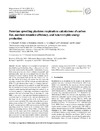Identificador persistente para citar o vincular este elemento:
https://accedacris.ulpgc.es/jspui/handle/10553/45661
| Título: | Peruvian upwelling plankton respiration: calculations of carbon flux, nutrient retention efficiency, and heterotrophic energy production | Autores/as: | Packard, T. T. Osma, N. Fernández-Urruzola, I. Codispoti, L. A. Christensen, J. P. Gómez, M. |
Clasificación UNESCO: | 251001 Oceanografía biológica | Palabras clave: | Plankton respiration | Fecha de publicación: | 2015 | Publicación seriada: | Biogeosciences | Resumen: | Oceanic depth profiles of plankton respiration are described by a power function, RCO2 = (RCO2)0 (z/z0)b, similar to the vertical carbon flux profile. Furthermore, because both ocean processes are closely related, conceptually and mathematically, each can be calculated from the other. The exponent b, always negative, defines the maximum curvature of the respiration–depth profile and controls the carbon flux. When |b| is large, the carbon flux (FC) from the epipelagic ocean is low and the nutrient retention efficiency (NRE) is high, allowing these waters to maintain high productivity. The opposite occurs when |b| is small. This means that the attenuation of respiration in ocean water columns is critical in understanding and predicting both vertical FC as well as the capacity of epipelagic ecosystems to retain their nutrients. The ratio of seawater RCO2 to incoming FC is the NRE, a new metric that represents nutrient regeneration in a seawater layer in reference to the nutrients introduced into that layer via FC. A depth profile of FC is the integral of water column respiration. This relationship facilitates calculating ocean sections of FC from water column respiration. In an FC section and in a NRE section across the Peruvian upwelling system we found an FC maximum and a NRE minimum extending down to 400 m, 50 km off the Peruvian coast over the upper part of the continental slope. Finally, considering the coupling between respiratory electron transport system activity and heterotrophic oxidative phosphorylation promoted the calculation of an ocean section of heterotrophic energy production (HEP). It ranged from 250 to 500 J d−1 m−3 in the euphotic zone to less than 5 J d−1 m−3 below 200 m on this ocean section. | URI: | https://accedacris.ulpgc.es/handle/10553/45661 | ISSN: | 1726-4170 | DOI: | 10.5194/bg-12-2641-2015 | Fuente: | Biogeosciences [ISSN 1726-4170], v. 12, p. 2641-2654 |
| Colección: | Artículos |
Citas SCOPUSTM
16
actualizado el 08-jun-2025
Citas de WEB OF SCIENCETM
Citations
14
actualizado el 08-jun-2025
Visitas
106
actualizado el 27-jul-2024
Descargas
122
actualizado el 27-jul-2024
Google ScholarTM
Verifica
Altmetric
Comparte
Exporta metadatos
Los elementos en ULPGC accedaCRIS están protegidos por derechos de autor con todos los derechos reservados, a menos que se indique lo contrario.
